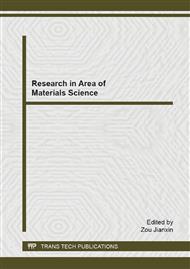p.156
p.161
p.169
p.176
p.181
p.189
p.194
p.199
p.204
Research on Plasticizing Properties and Mechanism of PVA
Abstract:
Taking glycerol as the plasticizer, through its effect on melting and crystallization of PVA, this paper researches on the plasticizing properties and mechanism of PVA, and provides experimental and theoretical basis for the realization of PVA’s melt processing. Research Methods: Matching samples respectively, mix each sample in an electric high-speed mixer with a mixing temperature of 80 °C. And then, put each sample in a Banbury mixer, mixing for 10 minutes with a rotational speed of 45rm/min. Take out each sample to analyze its characterization and do some tests, including infrared analysis, DSC test, X-ray diffraction test, and rheological curve measurement. Experimental Results: After adding glycerol, there exist two more absorption peaks near the point of 1621cm-1 in the PVA infrared spectrum, and the crystallization peak at 1267cm-1 is decreased gradually. In the DSC chart, when the amount of glycerol increasing to 16.67%, the melting point of PVA is decreased to 212 °C, and its melting range is 191 °C-223 °C. Under this condition, the melting range has been completely separated from the decomposition temperature range. X-ray diffraction shows that glycerol is added no significant effect on the diffraction angle of the PVA, the diffraction peak intensity decreased significantly increases the degree of dispersion. Under the same temperature, with the shear rate increasing, the shear viscosity has a downward trend; as the temperature increases, the shear viscosity and shear stress of the system are gradually decreasing. Conclusion: Glycerol may lower the melting temperature because it can improve the segmental mobility of PVA and reduce the crystalline regions. However, the amount of glycerol should not be too much, or the plasticizing effects will be drastically reduced because of the separation. The research also find that a certain amount of glycerol used alone cannot reduce the decomposition temperature but decrease the melting temperature, which still cannot meet the melt processing conditions. The excessive glycerol can easily be precipitated from PVA, resulting in the product surface being oily and crisp.
Info:
Periodical:
Pages:
181-188
Citation:
Online since:
April 2015
Authors:
Keywords:
Price:
Сopyright:
© 2015 Trans Tech Publications Ltd. All Rights Reserved
Share:
Citation:


